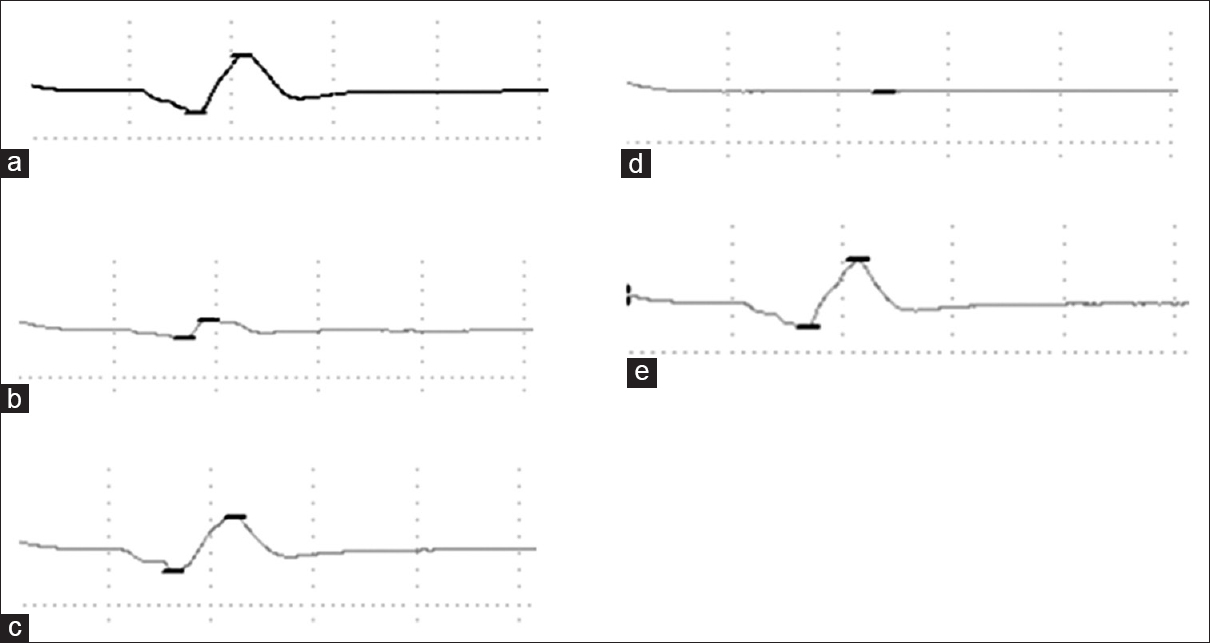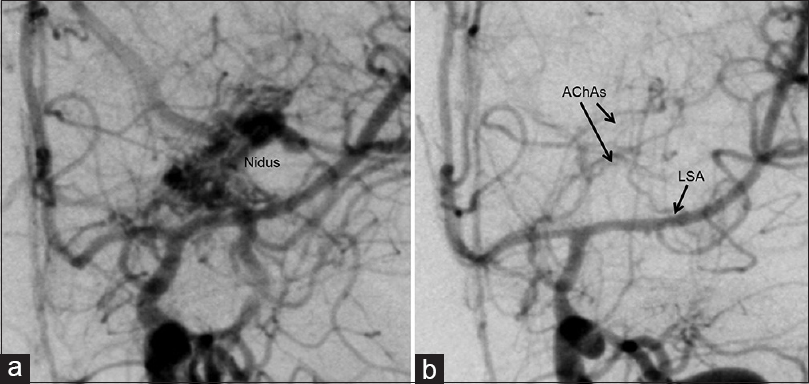- Department of Neurosurgery, St. Marianna University School of Medicine, Kawasaki, Japan
Correspondence Address:
Daisuke Wakui
Department of Neurosurgery, St. Marianna University School of Medicine, Kawasaki, Japan
DOI:10.4103/sni.sni_220_17
Copyright: © 2018 Surgical Neurology International This is an open access journal, and articles are distributed under the terms of the Creative Commons Attribution-NonCommercial-ShareAlike 4.0 License, which allows others to remix, tweak, and build upon the work non-commercially, as long as appropriate credit is given and the new creations are licensed under the identical terms.How to cite this article: Daisuke Wakui, Hidemichi Ito, Hiroshi Takasuna, Hidetaka Onodera, Kotaro Oshio, Yuichiro Tanaka. Surgical removal of an arteriovenous malformation in the anterior perforated substance in a pregnant woman. 07-Jun-2018;9:117
How to cite this URL: Daisuke Wakui, Hidemichi Ito, Hiroshi Takasuna, Hidetaka Onodera, Kotaro Oshio, Yuichiro Tanaka. Surgical removal of an arteriovenous malformation in the anterior perforated substance in a pregnant woman. 07-Jun-2018;9:117. Available from: http://surgicalneurologyint.com/surgicalint-articles/surgical-removal-of-an-arteriovenous-malformation-in-the-anterior-perforated-substance-in-a-pregnant-woman/
Abstract
Background:A tailor-made treatment is often required in arteriovenous malformations (AVMs) depending on the individual situation. In most cases, treatment strategy is usually determined according to the patient's Spetzler–Martin grade. However, in the present case, we were not able to treat the patient following the usual guidelines because of neurological symptoms and pregnancy.
Case Description:We describe a rare case of a 31-year-old woman in the 15th week of gestation who presented with an AVM in the anterior perforated substance (APS). She suffered a sudden coma and hemiplegia. A computed tomographic scan showed an enhanced mass and a huge hematoma in the basal ganglia and temporal lobe. The hematoma was successfully evacuated in an endoscopic procedure. Angiography showed that a 25-mm nidus in the APS was fed by the anterior choroidal arteries (AChAs) and the lenticulostriate arteries (LSAs). Therefore, we attempted to remove the nidus because the patient became alert with mild aphasia and hemiparesis 10 days after hemorrhage. The feeding arteries were cut under motor evoked potential (MEP) monitoring, and the nidus was totally resected leaving two of four AChAs and a single artery with several LSAs. The postoperative course was uneventful, and she gave birth to a healthy baby by caesarian delivery 122 days after the hemorrhage with only minor sequelae.
Conclusions:Surgical strategy with a device-administered anesthesia are suitable for removing large AVMs even in pregnant women and for the successful outcome of their pregnancies. Even after recovering from a coma and hemiplegia, MEP monitoring is effective for removing large AVMs even when located in the APS.
Keywords: Anterior perforated substance, arteriovenous malformation, motor evoked potential, pregnancy
INTRODUCTION
An American Heart Association (AHA) Scientific Statement described the management of arteriovenous malformations (AVMs) in 2001 as follows:[
Surgical extirpation of AVMs located in the anterior perforated substance (APS) is challenging because the surgical field is deep and vital arteries, such as the anterior choroidal arteries (AChAs) and the lenticulostriate arteries (LSAs), are in and around the nidus. The morbidity rate in the surgical treatment of basal ganglia AVMs is not low but 10–29%.[
CASE REPORT
A 31-year-old woman in the 15th week of gestation suddenly lost consciousness and was transferred to our institution. She was in a deep coma with her left pupil dilated and right hemiplegia. Computed tomographic scans showed an intracerebral hemorrhage in the left basal ganglia extending to the temporal lobe and a small, enhanced mass above the APS [
Figure 1
A computed tomographic scan showing an enhanced mass in the anterior perforated substance (a) associated with a huge hematoma in the basal ganglia and temporal lobe. Post operative CT showed the hematoma was completely removal (b). Angiograms revealed a nidus fed by the anterior choroidal arteries (AChAs) and the lateral lenticulostriate arteries (LSAs) (c) and drained by the basal vein of Rosenthal (BVR), the deep middle cerebral vein (DMCV), and the anterior communicating vein in the delayed arterial phase (d)
A bolus injection of rocuronium bromide (0.9 mg/kg) and propofol (2 mg/kg) was given before tracheal intubation. She received a continuous infusion of propofol (3–5 mg/kg/h) thereafter. An obstetrician monitored the fetal heartbeats. We performed an orbitozygomatic craniotomy and a partial temporal lobectomy to obtain a wide surgical field. A grid strip with 16 electrodes (Unique Medical, Tokyo, Japan) was inserted into the subdural space to facilitate electrical stimulation to the motor cortex (Neuropack X1, Nihon Koden, Tokyo, Japan). The filters were at 20 Hz and 3 kHz (low- and high-band passes, respectively). We confirmed the muscle action potentials from the contralateral thenar muscles. Intraoperatively, the motor cortex was stimulated at 2 mA above the threshold level. A monopolar anodal electrical stimulus with five pulses was applied. The frequency of the train pulse was 500 Hz, and the duration of each single pulse was 200 ms.
The internal carotid artery, the A1 segment of the anterior cerebral artery, and the M1 segment of the middle cerebral artery were all well exposed after widely opening the Sylvian fissure. More than 10 perforating arteries were found to feed the nidus in the APS adjacent to the M1 segment. There were four AChAs feeding the nidus, and the distal two were cut because the test occlusion for 5 min did not induce a depression of the motor evoked potential (MEP) [
Figure 2
The MEP records showing the change before and after clamping an AChA (a and b) and an LSA (c and d). The amplitude decreased 1 minute after occlusion of one of the four AChAs (b). The amplitude decreased 5 minutes after occlusion of the most lateral LSA (d). They recovered soon after the declamp and did not change at the time of the dural closure (e)
Figure 3
Intraoperative photos. One of the LSAs was found to enter the nidus (arrow) but proved to be a passing artery (a). The nidus was demarcated, and the BVR remained (b). The intraoperative indocyanine green (ICG) videoangiography showed that the LSA remained and reflux of ICG was found in the BVR (c)
DISCUSSION
AVM has a hemorrhage rate of 8.1% for each pregnancy or 10.8% per year.[
It usually takes 2 or 3 years for an AVM to resolve after radiosurgery. Therefore, AVMs are not obliterated during pregnancy. Unless the AVM is completely resolved, the risk of bleeding remains.[
Potts et al.[
MEP monitoring proved to be essential to avoid damage to the AChAs and LSAs in the present case. Three perforators in and around the nidus were preserved because the amplitudes disappeared in two AChAs and in a single LSA. Suzuki et al.[
How long is necessary to confirm the tolerance of the perforating arteries before their permanent occlusion? Horiuchi et al.[
During pregnancy, anesthetic gas is generally used to keep the uterus relaxed. However, the anesthetic gas disturbs MEP monitoring due to its muscle relaxing potency. We asked the anesthesiologist to use intravenous anesthesia and to monitor the fetal heart throughout the procedure. Bradycardia with <80 bpm for 2 min indicates fetal hypoxic damage.[
CONCLUSION
We described a rare case of a 31-year-old woman in the 15th week of gestation, presenting with an AVM in the APS who was comatose and hemiplegic. After regaining consciousness and motor function, the AVM was successfully removed with minimal neurological damage; she gave birth to a normal, healthy baby by caesarian delivery. This kind of surgery can be successfully performed provided the nidus is small, MEP is monitored efficiently, and the fetus is older than 15 weeks.
Consent
Written informed consent was obtained from the patient for publication of this case report and any accompanying images.
Financial support and sponsorship
Nil.
Conflicts of interest
There are no conflicts of interest.
References
1. Agarwal N, Guerra JC, Gala NB, Agarwal P, Zouzias A, Gandhi CD. Current treatment options for cerebral arteriovenous malformations in pregnancy: A review of the literature. World Neurosurg. 2014. 81: 83-90
2. Deruty R, Pelissou-Guyoat I, Morel C, Bascoulergue Y, Turjman F. Reflections on the management of cerebral arteriovenous malformations. Surg Neurol. 1998. 50: 245-56
3. Friedman WA, Blatt DL, Bova FJ, Buatti JM, Mendenhall WM, Kubilis PS. The risk of hemorrhage after radiosurgery for arteriovenous malformations. J Neurosurg. 1996. 84: 912-9
4. Fukuda K, Hamano E, Nakajima N, Katsuragi S, Ikeda T, Takahashi JC. Pregnancy and delivery management in patients with cerebral arteriovenous malformation: A single-center experience. Neurol Med Chir (Tokyo). 2013. 53: 565-70
5. Fukuda K, Matsuoka J, Takada S, Katsuragi S, Ikeda T, Iihara K. Utility of intraoperative fetal heart rate monitoring for cerebral arteriovenous malformation surgery during pregnancy. Neurol Med Chir (Tokyo). 2014. 54: 819-23
6. Garrido E, Stein B. Removal of an arteriovenous malformations from the basal ganglion. J Neurol Neurosurg Psychiatry. 1978. 41: 992-5
7. Gross BA, Du R. Hemorrhage from arteriovenous malformations during pregnancy. Neurosurgery. 2012. 71: 349-56
8. Horiuchi K, Suzuki K, Sasaki T, Matsumoto M, Sakuma J, Konno Y. Intraoperative monitoring of blood flow insufficiency during surgery of middle cerebral artery aneurysms. J Neurosurg. 2005. 103: 275-83
9. Horton JC, Chambers WA, Lyons SL, Adams RD, Kjellberg RN. Pregnancy and risk of hemorrhage from cerebral arteriovenous malformations. Neurosurgery. 1990. 27: 867-71
10. Kano H, Kondziolka D, Flickinger JC, Yang HC, Flannery TJ, Niranjan A. Stereotactic radiosurgery for arteriovenous malformations, Part 4: Management of basal ganglia and thalamus arteriovenous malformations. J Neurosurg. 2012. 116: 33-43
11. Lv X, Liu P, Li Y. The clinical characteristics and treatment of cerebral AVM in pregnancy. Neuroradiol J. 2015. 28: 234-7
12. Ogilvy CS, Stieg PE, Awad I, Brown RD, Kondziolka D, Rosenwasser R. AHA Scientific Statement: Recommendations for the management of intracranial arteriovenous malformations: A statement for healthcare professionals from a special writing group of the Stroke Council, American Stroke Association. Stroke. 2001. 32: 1458-71
13. Parer JT, Ikeda T. A framework for standardized management of intrapartum fetal heart rate patterns. Am J Obstet Gynecol. 2007. 197: 26e1-6
14. Potts MB, Young WL, Lawton MT. UCSF Brain AVM Study Project: Deep arteriovenous malformations in the Basal Ganglia, thalamus, and insula: Microsurgical management, techniques, and results. Neurosurgery. 2013. 73: 417-29
15. Suzuki K, Kodama N, Sasaki T, Matsumoto M, Konno Y, Sakuma J. Intraoperative monitoring of blood flow insufficiency in the anterior choroidal artery during aneurysm surgery. J Neurosurg. 2003. 98: 507-14
16. Webb JA, Thomsen HS, Morcos SK. members of Contrast Media Safety Committee of European Society of Urogenital Radiology (ESUR). The use of iodinated and gadolinium contrast media during pregnancy and lactation. Eur Radiol. 2005. 15: 1234-40










